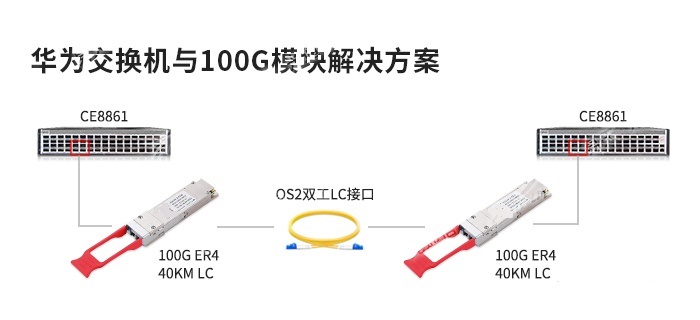Frequently Asked Questions About 100GbE QSFP28 Transceivers
1.What is QSFP28 transceiver?
A: The QSFP28 transceiver is a high-rate optical module for 100G Ethernet. It employs QSFP form factor. The QSFP28 transceiver has four signal channels, each with a maximum transmission rate of 28 Gbps. It is available in a variety of fiber link distances. The QSFP28 transceiver is used in the InfiniBand system, called EDR. EDR QSFP28 transceiver has stricter performance requirements.
2.What are the main applications of the QSFP28 transceiver?
A: The QSFP28 transceiver is mainly employed in the data center for 100G connections of core switches and core routers.
3.What are the main types of 100G transceiver?
A: There are QSFP28 transceivers, CFP4 transceivers, CFP2 transceivers, CFP transceivers.
Currently, the main 100G transceiver is the QSFP28 transceiver.
4.Is it possible to insert QSFP+ transceivers to QSFP28 fiber ports for use?
A: No. Different communication protocols were complied for different data rates.
5.What are the differences between SFP28 and QSFP28 transceivers?
A: They are different on data rate, form factor and working principle.
The transmission data rate of SFP28 transceiver is 25 Gbps, that of QSFP28 is 100 Gbps;
The form factor of SFP28 is SFP, that of QSFP28 is QSFP;
The SFP28 transceiver uses single-channel transmission and has a transmission rate of 25 Gbps;
The QSFP28 transceiver uses four channels of transmission with a transmission rate of 25 Gbps per channel.
7.Can the QSFP28 transceiver work with CFP transceiver?
A: Yes! Both are products of the Ethernet protocol and can interoperate with each other.
8.What is the operating temperature range of QSFP28 transceiver?
A: The standard operating temperature range of QSFP28 transceiver commercial version is 0°C to 70°C; that of industrial version is -45°C to +85°C;
Commercial version products are generally applied. There are also some data centers that use products with operating temperatures ranging from 20°C to 50°C to reduce costs.
9.What are the differences between transceivers QSFP28 CWDM4 and QSFP28 LR4?
A: The wavelength is different.
The operating wavelength of the QSFP28 LR4 transceiver is 1295nm, 1300nm, 1305nm, 1310nm, and the wavelength interval is 5nm;
The operating wavelength of the QSFP28 CWDM4 transceiver is 1271nm, 1291nm, 1311nm, 1331nm, wavelength interval 20nm;
The QSFP28 LR4 transceiver and the QSFP28 CWDM4 transceiver have different working wavelengths and cannot communicate with each other.
10.What are the differences between transceivers QSFP28 SR4 and QSFP28 LR4?
A: They are different in transmission distance, fiber core, interface type and price.
The QSFP28 SR4 transceiver supports link lengths of up to 70m over OM3 and up to 100m over OM4 multimode fiber with MPO connectors.
The QSFP28 LR4 transceiver supports link lengths of up to 10km over a standard pair of G.652 single-mode fiber with duplex LC connectors.
The QSFP28 SR4 transceiver requires 8-core fiber, while the QSFP28 LR4 optical module requires a 2-core fiber.
The interface of the QSFP28 SR4 transceiver is MTP/MPO interface, while that of the QSFP28 LR4 transceiver is the LC interface.
11.What is FEC (Forward Error Correction)? Does the QSFP+ module need to use the FEC function?
A: QSFP+ transceiver does not require FEC function.
FEC (Forward Error Correction) is a method to increase the credibility of data communication.
In a one-way transmission channel, once an error is found, the receiver will not have the right to request a transmission. FEC corrects errors during signal transmission. When an error occurs in the transmission, the receiver is allowed to reconstruct the data.
In the design of transceivers, the cost of FEC function is relatively high and is generally rarely used.
12.What is QSFP BIDI transceiver?
A: The QSFP Bidi transceiver refers to the QSFP+ single-fiber bidirectional (Bidi) optical module applied to 40G Ethernet. The QSFP Bidi transceiver is mainly used by Cisco, and there are fewer suppliers currently acquiring the technology.
The interface of the QSFP Bidi transceiver is a dual LC interface.
The transmission rate of the QSFP Bidi transceiver is 40 Gbps.
The operating wavelength of the QSFP Bidi transceiver is 850nm/890nm.
The QSFP Bidi transceiver is used on multimode fiber, supporting link distance is up to 100 meters over OM3 and up to 150 meters over OM4.
The QSFP Bidi transceiver has two signal channels, each with a transmission rate of 20 Gbps. Each channel can perform both transmit and receive operations on two wavelengths simultaneously. In this way, the access layer can be accelerated from 10 Gbps to 40 Gbps through two multimode LC fibers.




